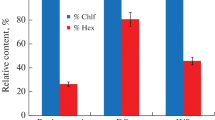Abstract
The migration of water-soluble fraction of petroleum hydrocarbons in typical soils of Bashkortostan is studied. The possibility of their water migration in Fluvic Phaeozems, Haplic Phaeozems, and Amphiskeletic Pantocalcic Chernozems is determined by data of a lysimetric model experiment. Dissolved organic substances, which pass into lysimetric waters from oil-contaminated soils, include the components that are not extracted by hexane, but are characterized by fluorescence in water at the wavelengths typical for petroleum products. These substances differ from soluble organic matter of background soils by higher HIX (humification indices) and presumably represent oxidized transformation products of petroleum hydrocarbons. Lysimetric waters from all oil-contaminated soils are biotoxic, regardless of the presence of nonpolar petroleum hydrocarbons. The toxicity T-index is in positive correlation with the content of dissolved organic carbon and chloride ions, accompanying oil pollution of soils.



Similar content being viewed by others
REFERENCES
Galkin, A.V., Lunin, A.F, Karyakin, A.V., and Petrov, S.I., Luminescence of water soluble components of oil and oil products, Zh. Prikl. Spektrosk., 1993, vol. 58, nos. 1–2.
Davydova, S.L. and Tagasov, V.I., Neft’ i nefteprodukty v okruzhayushchei srede: Ucheb. posobie (Oil and Oil Products in the Environment. Student’s Book), Moscow: Peoples’ Friendship Univ., 2004.
Kovaleva, E.I., Gorlenko, A.S., Yakovlev, A.S., Kegiyan, M.G., Makarov, A.O., and Makarov, A.A., Whether it is possible to use soil lysimeters for simulating migration of oil and oil transformation products, Izv. Samar. Nauch. Tsentra Ross. Akad. Nauk, 2014, vol. 16, no. 3.
Metodicheskie rekomendatsii po gigienicheskomu obosnovaniyu PDK khimicheskikh veshchestv v pochve no. 2609-82 (Methodological Recommendations for Hygienic Grounding of Maximum Allowable Concentration of Chemical Matters in Soils no. 2609-82), Moscow, 1982.
Mikhailova, L.V., Behavior features of water soluble oil fraction in model experiments, Vodn. Resur., 1986, no. 2.
Mikhailova, L.V. and Shorokhova, O.V., Composition and transformation features of water soluble fraction of the two types of Tyumen oil, Vodn. Resur., 1992, no. 2.
Motorykina, V.V., Sokolova, D.S., Zavgorodnyaya, Yu.A., Demin, V.V., and Trofimov, S.Ya., Influence of organic matter on the sorption of aromatic hydrocarbons by peat and chernozem, Moscow Univ. Soil Sci. Bull., 2008, vol. 63, no. 1, pp. 12–17.
Chen, H., Chen, S., Quan, X., Zhao, Y., and Zhao, H., Solubility and sorption of petroleum hydrocarbons in water and cosolvent systems, J. Environ. Sci., 2008, vol. 20, no. 10.
Delle Site, A., Factors affecting sorption of organic compounds in natural sorbent/water systems and sorption coefficients for selected pollutants. a review, J. Phys. Chem. Ref. Data, 2001, vol. 30, no. 1.
Huang, W., Peng, P., Yu, Z., and Fu, J., Effects of organic matter heterogeneity on sorption and desorption of organic contaminants by soils and sediments, Appl. Geochem., 2003, vol. 18, no. 7.
Kan, A.T., Fu, G., and Tomson, M.B., Adsorption/desorption hysteresis in organic pollutant and soil/sediment interaction, Environ. Sci. Technol., 1994, vol. 28, no. 5.
Karapanagioti, H.K., Childs, J., and Sabaini, D., Impacts of heterogeneous organic matter on phenanthrene sorption: different soil and sediment samples, Environ. Sci. Technol., 2001, vol. 35, no. 23.
Kohl, S.D. and Rice, J.A., Contribution of lipids to the nonlinear sorption of polycyclic aromatic hydrocarbons to soil organic matter, Org. Geochem., 1999, vol. 30, no. 8.
Maxin, C. and Kögel-Knabner, I., Partitioning of polycyclic aromatic hydrocarbons to water-soluble soil organic matter, Eur. J. Soil Sci., 1995, vol. 46, no. 2.
McAuliffe, C.D., Organism exposure to volatile/soluble hydrocarbons from crude oil spills. A field and laboratory comparison, Proc. Int. Oil Spill Conf., April 6–9, 1987 Baltimore, MD, 1987, no. 1.
Michel, J., Natural resource damage assessment of the amazon venture oil spill, Proc. Oil Spill Conf., February 13–16, 1989, San Antonio, TX, no. 1.
NOAA (National Oceanic and Atmospheric Administration), An introduction to coastal habitats and biological resources, Report no. HMRAD 92-4, 1992. http://response.restoration.noaa.gov/sites/default/files/ Monterey.pdf.
Ohno, T., Fluorescence inner-filtering correction for determining the humification index of dissolved organic matter, Environ. Sci. Technol., 2002, vol. 36, no. 4.
Rodrigues, R.V., Miranda-Filho, K.C., Gusmao, E.P., Moreira, C.B., Romano, L.A., and Sampaio, L.A., Deleterious effects of water-soluble fraction of petroleum, diesel and gasoline on marine pejerrey Odontesthes argentinensis larvae, Sci. Total Environ., 2010, vol. 408, no. 9.
Saeed, T. and Al-Mutairi, M., Chemical composition of the water-soluble fraction of leaded gasolines in sea water, Environ. Int., 1999, vol. 25, no. 1.
Shiu, W.Y., Bobra, M., Bobra, A.M., Maijanen, A., Suntio, L., and Mackay, D., The water solubility of crude oils and petroleum products, Oil Chem. Pollut., 1990, vol. 7, no. 1.
Smyrl, C.T., The effect of dissolved humic substances on the binding and biodegradation of polycyclic aromatic hydrocarbons in soil, MSc Thesis, Winnipeg, MB: Univ. of Manitoba, 2001.
Traversa, A., D’Orazio, V., and Senesi, N., Properties of dissolved organic matter in forest soils: influence of different plant covering, Forest Ecol. Manag., 2008, vol. 256, no. 12.
Williams, S.D., Ladd, D.E., and Farmer, J.J., Fate and transport of petroleum hydrocarbons in soil and ground water at Big Douth Fork National River and Recreation Area, Tennessee and Kentucky, 2002–2003, U.S. Geol. Survey Sci. Invest. Rep., 2006, no. 2005-5104.
Yang, M., Yang, Y.S., Du, X., Cao, Y., and Lei, Y., Fate and transport of petroleum hydrocarbons in vadose zone: compound-specific natural attenuation, Water Air Soil Pollut., 2013, vol. 224, no. 3.
ACKNOWLEDGMENTS
The authors are grateful to Cand. Sci. (Biol.) R.S. Aptikaev for soil samples and to Dr. Sci. (Biol.) E.Yu. Milanovskii for the assistance in determination of the contact angle of soil wetting.
Author information
Authors and Affiliations
Corresponding authors
Ethics declarations
Conflict of interests. The authors declare that they have no conflicts of interest.
Statement on the welfare of humans or animals. This article does not contain any studies involving humans or animals performed by any of the authors.
Additional information
Translated by I. Bel’chenko
About this article
Cite this article
Karavanova, E.I., Konovalov, A.G., Terskaya, E.V. et al. Migration of Water-Soluble Oil Components in Some Soils of Bashkortostan. Moscow Univ. Soil Sci. Bull. 76, 150–157 (2021). https://doi.org/10.3103/S0147687421030042
Received:
Published:
Issue Date:
DOI: https://doi.org/10.3103/S0147687421030042




